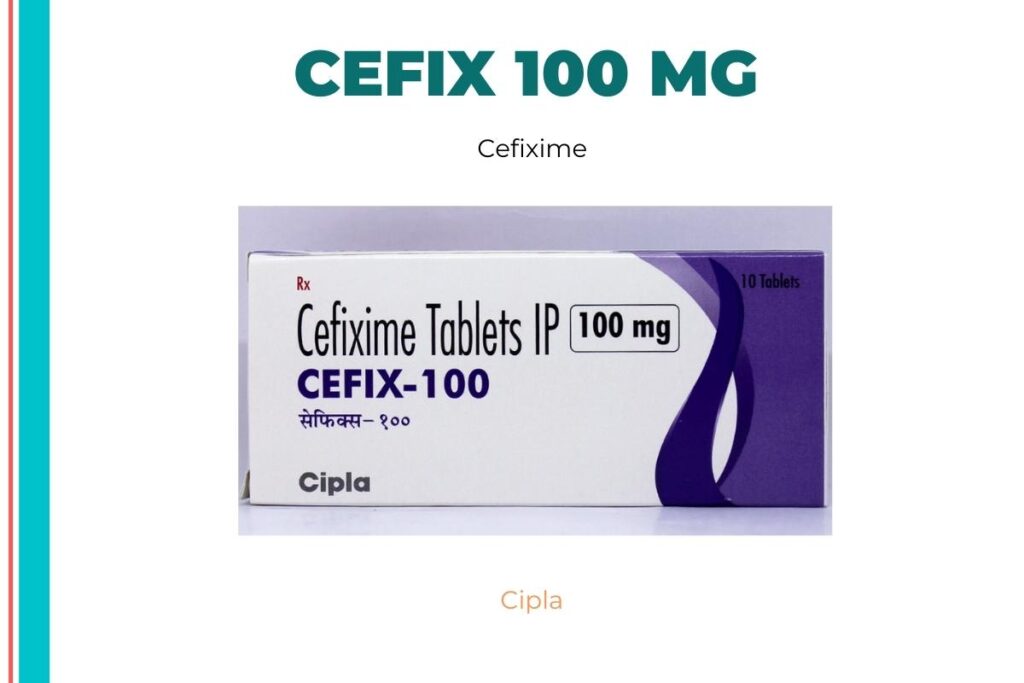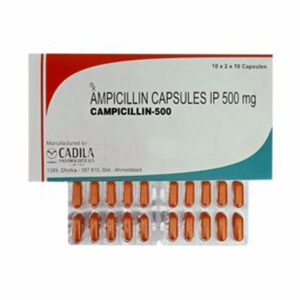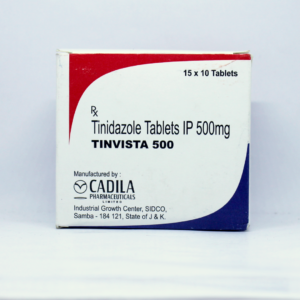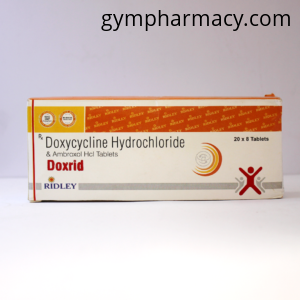Cefix 100 mg
Cefix 100 mg is a cephalosporin antibiotic that is commonly used to treat bacterial infections of the ears, lungs, and urinary system. It’s also used to treat sexually transmitted diseases (STDs) (Sexually Transmitted Diseases). Bacteria that are either infectious or dangerous can make you sick and proliferate swiftly in your body. Toxins are produced by these hazardous bacteria, which can damage tissue and make you sick.
Cefix 100 mg kills bacteria by inhibiting the chemical (mucopeptides) generated by the bacteria’s outer layer (cell wall). Cefix 100 mg weakens and kills the bacterial cell wall as a result. It is a wide class of antibiotics that may be used to treat a variety of bacteria. Cefix 100 mg is ineffective against colds, flu, and other viral illnesses.
Cefix 100 mg should be taken exactly as directed by your doctor, ideally with food to reduce stomach disturbance, and at regular intervals throughout the day for optimal effectiveness. Cefix 100 mg dosage varies based on your health and the severity of your infection. It’s also a good idea to finish the course of treatment even if you feel better since it’s an antibiotic, and skipping it might lead to a more serious illness that won’t react to the antibiotic (antibiotic resistance). Diarrhoea, nausea, loose stools, stomach discomfort, dyspepsia (indigestion), and vomiting are all frequent adverse effects of Cefix 100 mg. The above side effects do not have to be experienced by everyone. If you detect any sudden wheeziness, tightness in the chest or neck, trouble breathing, swelling of the eyelids, face, or lips, rash, or itching, consult a doctor (especially affecting your whole body) STOP TAKEING YOUR MEDICATION AND SEEK MEDICAL ATTENTION IMMEDIATELY.
If you have an allergy to any antibiotic, or if you have kidney or liver issues, please tell your doctor before starting Cefix 100 mg. Self-medication with Cefix 100 mg may result in antibiotic resistance, in which medications cease to work against certain bacterial illnesses. Before using Cefix 100 mg, see your doctor if you are pregnant or breastfeeding, suspect you are pregnant, or intend to have a kid. Cefix 100 mg is safe to take during pregnancy, as far as we know. During cefixime therapy, the possibility of temporarily stopping breastfeeding should be considered.
Cefix 100 mg is used for a variety of purposes.
Urinary tract infections (UTI), upper respiratory tract infections (URTI), lower respiratory tract infections (LRTI), gonorrhea (cervical/urethral), ear infections (acute otitis media), pharyngitis (pharyngeal inflammation), and tonsillitis are some of the most common illnesses (inflammation of the tonsils).

Medicinal Advantages
Cefixime is a short-term antibiotic that can be used to treat a variety of bacterial infections. It stops bacteria from growing by preventing the creation of a protective layer that is necessary for their survival. It protects against and treats bacterial infections such as urinary tract infections (UTI), upper respiratory tract infections (URTI), lower respiratory tract infections (LRTI), gonorrhea (cervical/urethral), ear infections (acute otitis media), pharyngitis (pharyngeal inflammation), and tonsillitis (inflammation of the tonsils). It also aids in the prevention of infection after burns, surgery, or dental procedures, as well as sexually transmitted diseases, bone infections, and scarlet fever (bacterial illness with strep throat).
Cefixime Side Effects
Cefixime, like other drugs, can have adverse effects, though not everyone experiences them. Diarrhea, nausea, loose stools, stomach discomfort, dyspepsia (indigestion), and vomiting are some of the most prevalent Cefixime side effects. The majority of Cefixime’s adverse effects do not require medical treatment and fade away with time. However, if the negative effects do not go away, see your doctor. Aside from that, if you feel abrupt wheezing, tightness in the chest or throat, trouble breathing, swelling of the eyelids, face, or lips, rash, or itching (particularly affecting your entire body), STOP TAKING YOUR MEDICINE and get medical attention right once.
Drug Recommendations
If you’re allergic to Cefixime or other macrolide antibiotics, don’t use it. Cefixime has been linked to hypersensitivity responses, including shock and death. If you have a response, stop using it right once and contact your doctor. If you have a liver problem (jaundice), a muscular problem (myasthenia gravis), a heart rhythm condition (arrhythmia), or an electrolyte imbalance, tell your doctor (low potassium or magnesium level). Cefixime can cause diarrhea in some people, so if you experience watery or bloody diarrhea, stop taking it and consult your doctor. However, wait till your doctor recommends you to use anti-diarrhea medicine. It is unknown whether Cefixime causes damage to the unborn child when used during pregnancy. If you are pregnant, planning a pregnancy, or nursing, talk to your doctor before using Cefixime.
Interactions Between Drugs
Cefix 100 mg may diminish the effectiveness of vaccinations such as cholera vaccine, live, typhoid vaccine, live, and Bacillus Calmette-Guérin vaccine (is used in a solution to stimulate the immune system in the treatment of bladder cancer and as a vaccine to prevent tuberculosis). You should wait at least 14 days after finishing your antibiotic medication before receiving any of the above-mentioned vaccines to ensure appropriate vaccination response. Cefix 100 mg can cause renal difficulties in some people, and taking it with furosemide may make it worse.
Drug-Food Interaction: Avoid eating a high-fat meal since your body will have a tougher time absorbing Cefix 100 mg. Grapefruit consumption during antibiotic therapy may inhibit the body from adequately using Cefix 100 mg. As a result, avoid grapefruit or grapefruit juice when taking antibiotics. Avoid consuming excessive amounts of calcium-fortified foods and beverages, since this may interfere with Cefixime’s effectiveness.
Cefixime should not be taken by those who have diabetes, renal failure, liver illness, seizure disorders, or colitis (a bowel disease that affects the large intestine and causes irritation, inflammation, and ulcers in the colon).
Safety Suggestions
ALCOHOL
When taking medicine, it’s important to stay away from alcohol.
PREGNANCY
Cefixime should only be administered if absolutely essential during pregnancy. Before prescribing it to you, your doctor will consider the advantages as well as any possible hazards. Please seek medical advice.
BREAST FEEDING
Cefixime should only be given to nursing women if the advantages of treatment are deemed to exceed the hazards to the baby. As a result, it is important to get medical advice before using Cefixime.
DRIVING
Drive carefully since Cefixime commonly causes sleepiness and disorientation, which impairs driving ability.
LIVER
Cefixime should be used with caution, especially if you have a history of liver problems. Your doctor may need to modify the dosage.
KIDNEY
Cefixime should be used with caution, especially if you have a history of kidney problems. Your doctor may need to modify the dosage.
No habit formation
Advice on Diet and Lifestyle
After taking the complete term of Cefixime, probiotics should be given to help restore some of the good bacteria in the intestines that may have been destroyed. Antibiotic-associated diarrhea can be reduced by taking probiotics following antibiotic therapy. Fermented foods such as yoghurt, cheese, sauerkraut, kombucha, and kimchi can aid in the restoration of intestinal healthy bacteria.
Include more fiber-rich foods in your diet since they are easier for your gut bacteria to digest, which aids in their growth. As a result, fiber diets may aid in the restoration of healthy gut flora following antibiotic treatment. Include entire grains in your diet, such as whole-grain bread and brown rice.
Cefixime’s effectiveness may be harmed if you consume too much calcium or iron-rich meals and beverages.
When using Cefixime, stay away from alcoholic beverages since they might dehydrate you and disrupt your sleep. This may make it more difficult for your body to help Cefixime fight infections.
Recommendations
After taking the complete term of Cefixime, probiotics should be given to help restore some of the good bacteria in the bowel that may have been destroyed. Antibiotic-associated diarrhea can be reduced by taking probiotics following antibiotic therapy. Fermented foods such as yoghurt, cheese, sauerkraut, and kimchi can aid in the restoration of healthy bacteria in the gut.
Include more fiber-rich foods in your diet since they are easier for your gut bacteria to digest, which aids in their growth. As a result, fiber diets may aid in the restoration of healthy gut flora following an antibiotic treatment. Whole grains, such as whole-grain bread and brown rice, should be part of your daily diet.
Avoid consuming excessive amounts of calcium-fortified foods and beverages, since this may interfere with Cefixime’s effectiveness.
When using Cefixime, stay away from alcoholic beverages since they might dehydrate you and disrupt your sleep. This may make it more difficult for your body to help Cefixime fight infections.
Other details: This item is non-refundable.
Concerns of Patients
A bacterial infection occurs when dangerous germs infiltrate our bodies, grow, and infect us. It may target any portion of the body and multiply swiftly. When bacteria infects you, you may have nonspecific symptoms such as fevers, chills, and exhaustion. Bacteria come in a variety of shapes, but the most common are spherical, rod-shaped, and spiral-shaped. Bacterial infections range from simple ailments such as sore throats and ear infections to serious diseases such as meningitis and encephalitis. Streptococcus, Staphylococcus, and E. coli are some of the bacteria that cause illnesses. A bacterial illness can affect anyone at any time. People with a weakened immune system or those using immunosuppressive medications, on the other hand, are more susceptible to bacterial infection.
FAQs
Cefix 100 mg can produce diarrhea, which might indicate the presence of a new infection. Call your doctor if you experience watery or bloody diarrhea. Use anti-diarrhea medicine only if your doctor recommends it.
If you forget to take your Cefix 100 mg, take it as soon as you remember. If the next dosage is approaching, simply skip that dose and take the following one when it is due. If you’re unsure, talk to your doctor. To make up for a missed dosage, do not take a double dose.
Cefixime is commonly used to treat urinary tract infections (UTIs).
Staphylococcus aureus, Streptococcus pneumoniae, Streptococcus pyogenes (the cause of strep throat), Hemophilus influenzae, Moraxella catarrhalis, E. coli, Klebsiella, Proteus mirabilis, Salmonella, Shigella, and Neisseria gonorrhoeae are among the bacteria that Cefixime can kill.
Cefixime is an antibiotic that is used to treat a wide range of bacterial infections. A cephalosporin antibiotic is the name for this kind of antibiotic. It works by preventing germs from growing.
Cefixime was shown to be efficacious and well tolerated in the treatment of bacterial sinus infections in adults.








Leave a Reply
You must be logged in to post a comment.